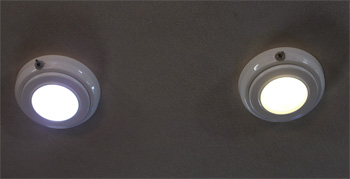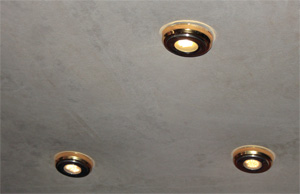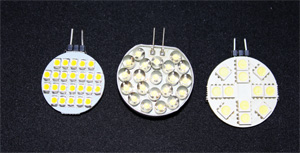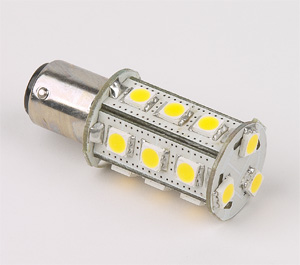Saving power has always been a challenge aboard any cruising vessel. Lighting for both interior and navigational lights has been a major factor in that power use. In the past there were not many options for electric lights aboard a boat. The choices were mainly incandescent or fluorescent lights, both having their drawbacks. The standard incandescent lights available were not particularly energy efficient, often producing as much heat as light, which translated into wasted energy. The word “incandescent” means to produce light by heating something, not the best way to produce light on the limited energy budget of a boat at sea.
Over the last 10 years or so there has been a revolution in lighting with the advent of efficient, cost-effective light emitting diode (LED) lighting. Initially, LED lights were expensive when compared to traditional incandescent or fluorescent lights. Now, however, prices have come down as new manufacturing processes are being developed and demand increases. Manufacturers have had to overcome the problems with the color of the light produced from these bulbs as well. When first introduced, most LED lights produced a somewhat cold, blue-hued light that was not very attractive for indoor lighting. This combined with the high cost kept many away from this new energy-efficient technology.
 |
|
An LED replacement bulb designed for a dome fixture. |
When the U.S. government mandated the phase-out of incandescent lights that began in 2012 for home use, LED manufacturers kicked into high gear in an effort to overcome some of the issues associated with LED lights. They learned new ways to produce lights with clustered bulbs that could deliver the light level required and they found ways of producing lights with the warm colors we were used to with the old incandescent lights.
Retro-fitting bulbs
Most boats built today are equipped with LED lights, but what about those of us with older boats that want to make the changeover? Fortunately, LED bulb manufacturers have taken this into account and now produce bulbs that will fit almost any existing fixture and socket. There are a few things to take into consideration when selecting replacement bulbs, however. Before running out to load up with LED bulbs, it helps to understand a bit about how these new lights work and what are the best options for your boat.
LED bulbs are semi-conductors that emit light when an electrical current is passed through them. Unlike incandescent bulbs that heat a tungsten element, which in turn produces light, the semi conductors excite electrons to produce light.
Because LEDs are semi-conductors, they are more sensitive to voltage fluctuations often found aboard the typical boat. This is important to understand because these voltage fluctuations can reduce the life span of the LEDs. Looking at an LED bulb, one can see that they are not a single bulb but rather a cluster of LED elements — the technology is not yet available to produce a single element that is bright enough for most uses.
 |
|
Different colors of LED lamps, cool white on the left, warm white on right. |
|
Wayne Canning |
When shopping for LED bulbs you’ll notice that the old standards of rating a bulbs output simply do not apply to LEDs. Incandescent bulbs are rated in watts and all produce pretty much the same light for the same wattage. Because LED bulbs use much less power (typically 1/3 to 1/30 less) for the same amount of light we can no longer use wattage as a measurement of output. To make matters worse not all LEDs will produce the same light at the same power level, so picking the right bulb becomes even more of a challenge. It also has to be kept in mind that as LED lights get older they lose some of their brightness so this has to be accounted for as well.
So how to know what bulb to get to replace existing lights and not feel like you are in a dimly lit bar or back ally? The answer is not simple. LED light output is measured in lumens not watts. The average 100-watt incandescent bulb produces about 1,600 lumens. So a 20-watt bulb would produce around 320 lumens. Although there is not direct conversion due to the varying efficiency of LED lights, this should help guide the buyer when it comes to selecting the right replacement bulb. The good news is that a 300-lumen LED bulb will likely draw less than five watts, an impressive power savings when you add up the number of bulbs in the average boat. Another thing to consider is that LED lights are directional whereas incandescent bulbs are not. Incandescent bulbs will use reflectors to make them directional, but this of course results in some wasted light output. This will likely mean that you can get by with a lower lumen value for the LED light as the light is not wasted on the back of the bulb. Of course this is also a drawback when seeking an omni-directional light such as a table lamp, but there are LED bulbs with full 360-degree clusters to make up for this.
When LED lighting first became available, one of the biggest complaints was the bluish color of the light which many people found hard to live with. Fortunately light manufacturers have overcome this and LED bulbs are now available that have the same warm color as most incandescent bulbs.
 |
|
Halogen bulbs have been replaced by LED bulbs in these overhead dome fixtures. |
|
Wayne Canning |
LED light color is measured by the color temperature or the correlated color temperature (CCT). The CCT uses the Kelvin temperature measurement scale. It describes the relative color appearance of a white light source, indicating whether it appears more yellow/gold (“warm”) or more blue (“cool”). More often than not the terms “warm white” or “cool white” will be used. The warm whites are lower on the temperature scale and range around 2,500 K to 4,000 K. The cool whites will range around 4,500 K to 6,000 K; the higher the number the bluer and cooler the light. This may all sound like more information than needed, but this information will prove helpful when selecting the right bulb.
Unlike incandescent bulbs, LED lights require some circuitry to control voltage to the individual LEDs in the cluster. As with any electronics, each manufacturer will use their own designs and circuits. This means there can be major differences in the performance and life span of the bulbs. The electronics will compensate for voltage fluctuations often found in boats, protecting the LEDs from damage and premature failure. In some cases this circuitry can cause radio interference aboard so always test all equipment after installing a new light.
Replacing entire fixtures
For navigation lights it is strongly recommended to replace the whole fixture with units that are designed for use with LED bulbs. The reason for this is that navigational lights need to meet USCG standards for visibility and color. If just replacing bulbs, make sure to use ones that are approved for navigational lights and that you use red and green bulbs for side lights. Not all LED bulbs will be bright enough and some will change color when behind a red or green lens. This is particularly true with the cool white bulbs as they produce more blue light. For bi- or tri-color lights it is best to use bulbs with different color clusters in the bulb. Some LED lights may cause interference with radios and other electronic devices. This can be particularly true with masthead lights placed near antennas.
 |
|
Typical LED replacement bulbs for G4 halogens. |
|
Wayne Canning |
Of course, the reason for changing from incandescent lights to LED is to save power, but just how much power will you save? This depends on the number of lights replaced, the efficiency of the replacement bulbs and how long the lights are used while underway or at anchor. Generally speaking it is best to replace navigational lights and cabin interior lights first as these will be turned on the longest and use the most power. The average bulb replaced on any given vessel is 20 watts or 1.6 amps at 12.5 volts. Assuming an average 300-lumen LED bulb that has a power draw of 3 watts or 0.25 amps, it can be seen there is a power savings of 1.4 amps per bulb. If replacing three running lights and perhaps eight interior lights, this translates into about 15 amps. If the running lights are on for 10 hours and the interior lights three hours during an average night at sea this would translate into 86.4 amp hours for incandescent bulbs and 13.5 amp hours for LED. This is a substantial power savings over the night. These are just estimated values for an average boat and results will vary, but these numbers clearly illustrate the power savings.
Because the LED lights draw less power, the question becomes should there be any change to the boat’s wiring or breakers when replacing lights? Although it is true — a smaller wire can be used with less current draw — there really is no reason to go to the trouble of replacing the wires. A larger wire than needed will only result in a lower voltage drop which is not a bad thing. As for fuses and breakers, it might not hurt to use a lower amp rating. The main purpose of the breakers is to protect the wiring not the device at the end of the wire. Assuming the breaker is correctly sized to start with there is no real need to change it. With a lower power draw, however, it would add an additional level of protection if it was replaced to match the load. Another thing to consider with wiring is the polarity. As incandescent lights have no polarity requirements, many boatbuilders do not pay much attention to this when connecting fixtures. LED lights, however, will not work with reverse polarity. Before installing any new LED bulb, check the socket polarity first, at best if wrong the light will not work and at worst the light could be damaged; never assume anything when it comes to boat wiring.
 |
|
An LED bulb from Imtra designed for use in a navigation light fixture. |
|
Courtesy Imtra Corp. |
Setting the mood
This is one of the fun parts of using LED lights; you can set the mood inside the boat by using different colored lights. For example in my boat I use warm white lights in the saloon for a warm soft feel to this area. In the galley and head I use the cool white lights for better clarity. It has also been reported that the cool white lights are better for reading so these would be a good choice for reading lights. Red or blue lights work well for low-light foot and step lighting and of course one can get creative with accent lighting. Some lights can produce two or more colors from the same bulb simply by switching it on and off quickly, offering even more options.
Incandescent bulbs are slowly becoming a thing of the past; it only makes sense to switch to the more energy-efficient LED bulbs. Understanding a bit about how these bulbs work and what to look for will help avoid disappointments with this new lighting choice. Although LED bulbs are more expensive, they last longer, are vibration resistant and in some cases waterproof. This is one simple upgrade any owner can easily tackle themselves and the results will be well worth the expense and effort.
————-
Capt. Wayne Canning lives on his Irwin 40 Vayu, in Wilmington, N.C. A marine professional for more than 35 years he is now a full-time marine surveyor, freelance writer, and consultant/project manager on major repairs. Canning also runs websites for those restoring project boats. Visit www.4ABetterBoat.com and www.projectboatzen.com for more information.

